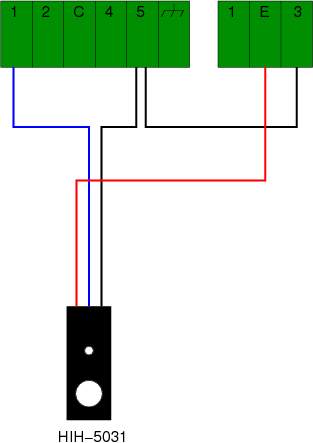SQ2040 datalogger and HIH-5031 humidity sensors
This post will show you how to connect HIH-5031 humidity sensors to a Squirrel SQ2040 datalogger. The advice will also be applicable to many other sensors with three connections for power, signal (voltage), and ground.
First, you need to make the actual physical connections. For these particular sensors the connections should be as follows (assuming the signal is being taken to the first input of block C):

Additional sensors may be connected to the other logger inputs and use the same power connections. Note that pin 5 on the input block is connected to ground. This is because the signal is measured relative to this. If it is floating then you will get bad readings (for example, I saw very a small negative input).
The following picture shows my logger connected to eight humidity sensors using this connection method. The terminal block in the centre is to make the positive power connection easier.

Now for the logger configuration. For this I will assume that you are using SquirrelView. Click on Logger Setup and enter sensor details as shown below (you may have to click through to the full-size image, it’s quite wide):

Note that the sensor power option isn’t present in the usual sensor setup dialog and will have to be set afterward. If this isn’t set then power won’t be supplied even if you enable the power output option. This caught me out at first. Once you have enabled power for the individual sensor, the actual power output is enabled via the following setting at the bottom of the window:

Now upload the configuration to the logger and try it out. If everything has been set up correctly you should be able to see the voltage being output by the sensor.
It is possible to have the logger perform the conversion from a voltage to a humidity reading. However, it must be compensated for temperature, so I decided to perform the entire conversion as a post-processing step.
